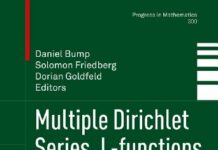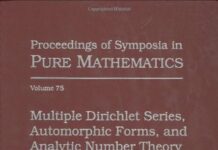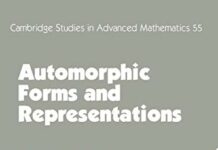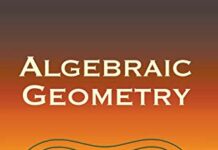
Ebook Info
- Published: 1998
- Number of pages: 592 pages
- Format: PDF
- File Size: 9.03 MB
- Authors: Daniel Bump
Description
Intermediate in level between an advanced textbook and a monograph, this book covers both the classical and representation theoretic views of automorphic forms in a style which is accessible to graduate students entering the field. The treatment is based on complete proofs, which reveal the uniqueness principles underlying the basic constructions. The book features extensive foundational material on the representation theory of GL(1) and GL(2) over local fields, the theory of automorphic representations, L-functions and advanced topics such as the Langlands conjectures, the Weil representation, the Rankin–Selberg method and the triple L-function, examining this subject matter from many different and complementary viewpoints. Researchers as well as students will find this a valuable guide to a notoriously difficult subject.
User’s Reviews
Reviews from Amazon users which were colected at the time this book was published on the website:
⭐it is pretty good, I like it, I get it pretty soon ,almost after two days I order it, the book is brand new
⭐Only good when read in combination with other sources such as Jacquet-Langlands. Very unmotivated unless you already know how all the results fit in the general framework of automorphic representations of GL(n). Nevertheless, it contains all proofs and is self-contained. It’s is full of mistakes (mostly misquoting Lemmata/Proposition but also few more substantial ones), which makes reading annoying at times!
⭐It’s one of the first books on the subject, but I don’t like it. A lot of it is unmotivated and disorganized. Why, for instance, does Bump spend time on the Doi-Naganuma lift? There are reasons, but you don’t see the forest in this book, so to speak. I would not recommend it to people who want to learn about automorphic forms.A good place to start are two articles by Knapp: “Prerequisites for the Langlands Program” and “First Steps with the Langlands Program.” A good entry way for modular forms is to read Buzzard’s short introduction in The Princeton Companion to Mathematics, and then read the relevant chapter in Serre’s Course in Arithmetic. Kilford wrote a readable and relatively short introduction to modular forms. Modular forms are complex analytic objects with surprising links to number theory. Some of these connections are largely analytic — for example, the Ramanujan tau-function, but some of this is algebraic — Eichler somehow discovered a connection to elliptic curves in 1954. (A good book on elliptic curves is the book by Knapp.) This, in part, led to the “modularity conjecture” (Taniyama-Shimura-Weil conjecture) which was proven in the 1990’s. The passage from classical modular forms to automorphic forms, and from automorphic forms to automorphic representations, is explained in a volume called “Lectures on Automorphic L-Functions.”I think people who want to know learn what is going on with automorphic forms would be disappointed with this book. It is an OK reference but it tries to cover too much in too little detail.
⭐The first chapter of this book is over 100 pages and is a great introduction to classical automorphic forms, and explains why we are interested in looking at L-functions arising from automorphic forms. It has the clearest proof I’ve seen of the dimension formula for the space of modular forms of weight k for the full modular group. The book also has the best presentation I’ve seen of Hecke operators. The exercises in the book are well chosen and have enough hints that they are actually doable by a patient reader. Maass forms are introduced much better here than in Iwaniec’s book. Bump is a careful and precise writer, and this book is a pleasure to read. I highly recommend it.
⭐Automorphic forms have become a vast subject these days with many interesting problems, for example in the Langlands program. Nonetheless there are very few books that lead a beginner to the frontier of research. In fact there are very few books that are good enough to give readers a start at the subject. This book, albeit not very good, is one such rare book that serves this purpose well.This book starts with a. chapter of classical modular and Maass forms, which is pretty nice itself. The latter chapters cover the automorphic forms on GL_2 over Q, in adelic setting. Chapter 2 covers the real place (representation theory of GL_2(R)), and Chapter 4 covers the non-archimedean place. (representation theory of GL_2(Q_p)) Chapter 3 then puts them back together.The reason I don’t like this book so much is that it does not convey the big picture well. To this reader there are often too many details that mask the current goals. One example is: How does one make the transition from classical modular forms to adelic automorphic forms? This is hidden in the middle of Chapter 3, while personally I think this should be the first thing one sees after Chapter 1. For this reason, I like Stephen Gelbart’s “Automorphic forms on adele groups” much better, as it is very successful in giving big picture. Unfortunately, Gelbart’s book contains no details and I can find no book other than Bump to fill the details in for this purpose.Bushnell and Henniart has a book on the representation theory of GL_2 over non-archimedean field, which is better than Bump’s chapter 4 in my opinion. Yet it doesn’t cover the theory over archimedean place. Knapp’s book that overviews the representation theory of semisimple real groups would cover this purpose, but is perhaps too long/more troublesome to extract information if one wants to learn in detail the case of GL_2. Perhaps one can never evade the Corvalis 77 volume to learn all these stuff. Still, it’s frustrating that there is no single, definitive starting point for a beginner in automorphic forms. Ideally, one would combine big picture in Gelbart’s book together with some details in Bump’s book. Before any such book exists though, Bump is still probably the best place to start on automorphic forms.
⭐good
Keywords
Free Download Automorphic Forms and Representations (Cambridge Studies in Advanced Mathematics Book 55) in PDF format
Automorphic Forms and Representations (Cambridge Studies in Advanced Mathematics Book 55) PDF Free Download
Download Automorphic Forms and Representations (Cambridge Studies in Advanced Mathematics Book 55) 1998 PDF Free
Automorphic Forms and Representations (Cambridge Studies in Advanced Mathematics Book 55) 1998 PDF Free Download
Download Automorphic Forms and Representations (Cambridge Studies in Advanced Mathematics Book 55) PDF
Free Download Ebook Automorphic Forms and Representations (Cambridge Studies in Advanced Mathematics Book 55)




